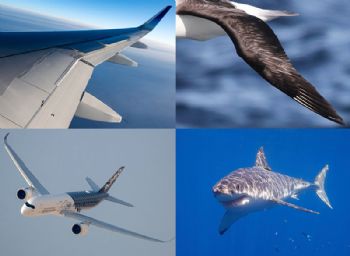
The science of ‘biomimicry’ — the design and production of materials, structures and systems that are modelled on biological entities and processes — is helping Airbus engineers to learn quite a lot about efficient solutions for aircraft design.
For example, the traditional method of helping an aircraft cut through the air is to make every surface as smooth as possible, but the study of sharks suggests that there is more to be done in this area.
Sharks are renowned for their speed through water, but their skin is not smooth, it is covered in small tooth-like ‘riblets’.
For the past two years, certain Airbus aircraft have had small riblet patches applied to the fuselages and wings to mimic the effect of shark skin. This has produced a reduction in drag that is particularly effective during high-speed cruising.
The albatross is also of interest to Airbus engineers, as it can cover hundreds of kilometres with hardly a flap of its wings.
Airbus (
www.airbus.com) engineer Tom Wilson noted that, in addition to the bird’s expert use of air currents, the aspect ratio of its wings (the span divided by the width) is significantly greater than that of Airbus aircraft today.
Mr Wilson said: “Seeing how nature has solved the engineering problems that an aircraft manufacturer faces gives us the feeling that we are asking the right questions.”
Various Airbus departments are applying the principles of biomimicry to their work and partnering with others to help advance the science.
A publicly funded research project led by Airbus with Lufthansa Technik and Bremer Werk für Montagesysteme continues to explore the use of material similar to shark skin on aircraft.
The research team recently developed a technique that allows the automated large-area application of a thin riblet structure to wings, and Airbus is considering the introduction of this type of coating to the wings and horizontal tails of A350 XWB aircraft (beginning in 2020).
Airbus is looking to launch incubation projects to see how bio-inspired insights might be further explored.
Lee-Ann Ramcherita, Airbus’s ‘technowatch and innovation manager’ in flight physics, said: “We want to see how we can learn from the things around us to potentially resolve the issues we face.
“Understanding how insects, birds or bats detect and respond to fluctuations in the surrounding air-flow may help us identify new technologies that could be applied to our aircraft.”